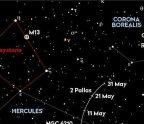
One of the greatest achievements in the history of space exploration was the Grand Tour, NASA's ambitious mission of the late 1970s and ’80s to visit the Solar System's outer planets using the twin Voyager space probes. They flew from world to world in a series of fascinating fly-bys, sending back incredible images of the planets which are still iconic today.
There will never be another Grand Tour, but this month we will be able to go on our own ‘Grand Tour’ of Jupiter, Saturn, Uranus and Neptune as the four planets will be stretched out across the heavens in a long line. Observers with Go-To telescopes will be able to navigate from one world to another just by pressing a few buttons, but less experienced observers will find they have help from the Moon, which will hopscotch along the planetary parade over the course of a week in December.

The big picture
Go out on any clear night, or morning, and the chances are that there will be at least one planet in the sky for you to enjoy looking at with just your eyes or through binoculars or a telescope. Sometimes a couple of Earth's distant sister worlds come together in the same part of the sky – a grouping astronomers call a conjunction






